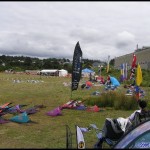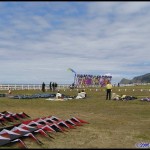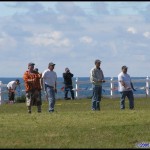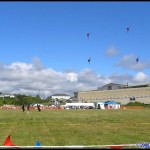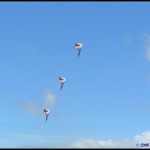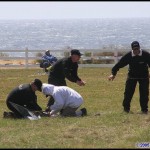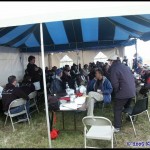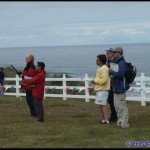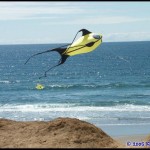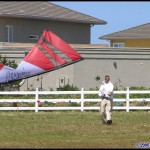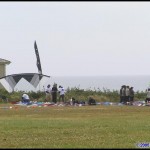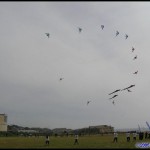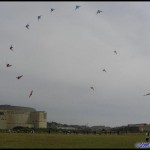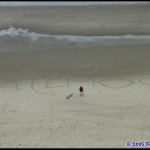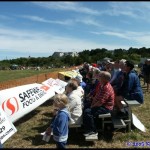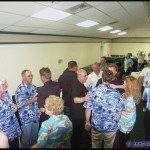All right… We’ve just come through the first KITING World Championship event held in the USA in quite a while. Yep, the World Sport Kite Championships (or WSKC) went off without a hitch, running from the 21st to the 24th of June, in Lincoln City, Oregon, USA. Many Kudos to all concerned, and a HUGE Thanks for what, at times, must have been an extraordinary effort! I have to tell you, it sure isn’t easy putting on one of these world-wide affairs, folks!
Let’s start our thinking about a year ago. Following the 2004 WSKC, the AKA stepped up to the bar – wanting to host the 2005 WSKC in the USA. Previous WSKCs had all be held in Berck sur la Mer, France. Perhaps time for someone else to host the event? So the American Kiting Association (AKA), along with STACK from Europe and AJSKA from Japan agreed to have the AKA host the 2005 WSKC in the USA, providing requirements could be met. AH… therein lies the rub, for “working out” all the requirements meant:
- Coming up with a suitable venue.
- Gathering the necessary funds to cover transportation, pay for the the rooms and meals, and cover all other event expenses.
- Actually organizing the whole effort.
No small endeavor for an organization that’s really a bunch of unpaid volunteers in a nationwide “club.”
The initial efforts went into selecting a location, under the direction of the AKA. After bid-letters were sent out and responses received, the field narrowed itself down to two locations, with Lincoln City, Oregon eventually coming out on top. As part of the bids received, Lincoln City specified a certain amount of funds it could deliver through sponsorships, though additional funds would also be required. And the event still needed to be “organized.” Well, the AKA and Lincoln City together managed to attract over 50 sponsoring companies and organizations – and I’ve no idea if they lost money, paid the bills, or even made a small profit – but no matter. The event went off as scheduled, which is what was really required. And the “Organization?” Well, they brought in the Best of the Best, Sue Skinner, as the organizer and she simply dug down deep and “got ‘er done!”
Easy? Nope! But Successful? Most assuredly!
And as Kitelife has been noting for several weeks, we were there to bring you much of the WSKC action via our “Daily Updates.” If you’ve not had a chance to follow the WSKC events as they occurred, the updates are still out on Kitelife, and you can still read and view the events. If you want the day-to-day WSKC nitty-gritty, that’s where to find it, and there’s no use us recapping when you can go right to the original text. Yeah – your “back button” should get you right back here when you’re done… For the Updates, click HERE.
As we mentioned in earlier issues of Kitelife, the competitions for the WSKC consisted of each team flying three Precision routines, each one consisting of three compulsory team figures, plus a short “precision” freestyle routine. In addition, each team would also fly three Ballet routines to music of their own choice. The lowest score in each discipline (both Precision and Ballet) were dropped for each team, and the average of the team’s remaining scores would be the team’s score for the entire event – winner take all! This format is readily accepted by all involved. The awards would be given at an event banquet at the end of the entire World Sport Kite Championships.
And now, I’m gonna take you behind the scenes for a bit and give you something of an “Insider’s Look” at the whole WSKC event…
John Barresi and I showed up at Lincoln City early on Sunday afternoon, with the competitions due to start on Tuesday – and I’m really glad we did. It was our chance to get to know several of the teams before the competitions began even though I already knew every member of both 6th Sense and Cutting Edge, and we just went for it. By the time Tuesday morning rolled around, we’d met Kamikaze, Flame, Elément’Air, 6th Sense, Watnu, Garuda, Tame Bird, Neo, and AirZone (listed here in the order we’d met them and watched them practice on the beach).
I’d not developed any preconceived notions of who “should” win the competition by the time the actual event flights started, but several teams already looked to be contenders, including a couple who eventually made the top three (We’d not seen Cutting Edge fly yet). I’d also sort of noted a couple who I felt would NOT be in contention, though I’d not seen all of the teams fly as yet… I guess I’m saying that I hadn’t “handicapped” the event and was simply content to let the best team go out on the flying field and just “prove it.”
When Tuesday rolled around, each team flew a practice round and a Ballet event, and I’d still not reached any conclusion at all by the end of the day. Only one of six comp events were in the bag, and with the somewhat crappy weather conditions, I wasn’t ready to call anything yet. Gosh – this might be the worst day of the entire event, and all these scores might be thrown out as “low scores.” WAY too early to predict!
Speaking of “low scores,” I had a short, but quite interesting, discussion with Judge Mike Huff Tuesday evening at Dave Gomberg’s party. I didn’t knock the scoring at all (would never do that – NOT my place to do it), but wondered aloud to Mike about upper scores between 70 and 80 during somewhat ugly weather conditions. So if weather happened to improve to “excellent” for the next few days, was it possible for teams to be flying scores in the high 80s or even low 90s then – which is relatively unheard of? Mike said he understood my question, but had no answer for it. He also noted, quite correctly, that the scores I was seeing were the averaged scores of five judges, of which he was only one. While I didn’t get the answer to my question, I understood that the scores I was seeing were the consensus results of five separate world-class judges! Time to walk away and let the question drop.
Anyway, by the completion of Wednesday’s flight-schedule, it was looking very much like Cutting Edge (US) and Tame Bird (FR) were definitely in early contention. I’d seen Tame Bird practice-flying Sunday evening in very steady 3-4 MPH breezes on the beach and was just blown away by some of the awesome maneuvers they were flying. They also seemed to have a “tightness” of form – as if they were mind-readers on their turns and alignment. John Barresi, on the other hand, pointed out that, with Cutting Edge in the lead (though not much of one), the competition was theirs to lose rather than someone else’s to win – and Cutting Edge looked pretty “hungry!” Still, with the lead being so small, nobody had anything like a commanding lead, and the title was still very much up for grabs. As it turns out, this scenario would not change at all for the remainder of the WSKC event… Cutting Edge would continue to lead, but a stumble could have cost them the title. Tame Bird would diligently try to close the gap, but as it turns out they were never able to accomplish it.
Yes, most of the eyes were on the leaders by Wednesday night, but there were also other teams worthy of note. For one, Air-Rex (JP) was doing very well, and Kamikaze (JP) and Neo (JP) were not that far behind. I’d heard some people dismissing the Japanese teams, but that turned out to be an error on their part. All of the Japanese teams flew creditable performances, and it became clear that these teams were strong, competent, well practiced, and capable… and they would be in contention throughout the tournament. Indeed, it was only on the last competition day that Watnu came roaring up to snatch third place away from Air-Rex. Look for Japanese teams to be in strong contention in the coming years.
Speaking of Team Watnu (GR), I had an early taped interview conversation with Stefan Scheider of Watnu, and came away impressed with both his answers and his attitude. Early on, I felt that Watnu was capable of better scores than they were getting. All that finally proved out for them when later flight scores replaced some early low scores and brought them into contention. Indeed, outright winning the high score in precision on the final day allowed Watnu to edge Air-Rex by about two points to win third place overall. Their precision score on that last day was 79.28 – and the score it replaced was a dismal 52.14 they’d flown in precision the day before – a difference of 27.14 points, and quite a jump! Team Watnu was certainly the most surprised team to “trophy” at this year’s WSKC, and they may well be capable of winning it all next year!
On the “down side,” those who knew members of teams Elément’Air (FR) and 6th Sense (US) saw their hopes fade over the week. Elément’Air won the Championship outright at the 2004 WSKC in Berck sur Mer, but it seems that 2005 was just not their year. Plagued by bumpy, inconsistent winds and one mishap after another, Elément’Air ended up back in the pack. I think they’re better than the scores indicate and I’m impressed by the ability I saw from them on the beach, but it just didn’t make it onto the competition field this year. The same is quite true of Team 6th Sense. The team seemed at times to struggle with having the “right kite” for wind conditions and was fighting the bumpy winds a fair amount of the time, and this year’s WSKC just didn’t seem to “gel” for 6th Sense somehow. They’re certainly better pilots than they showed this year.
Other mid-pack teams also seemed to battle a bit with the bumpy and inconsistent winds, and indeed, we never really encountered clear, steady air during the entire WSKC. Three teams also battled with flight-line difficulties during the competitions. AirZone (US) had the misfortune to encounter broken flight-lines twice, and was unable to re-launch the downed kite within the 45 second time limit. And Robin Smith of the Scratch Bunnies (UK) broke a flight-line at the end of one of their Precision freestyle routines, and with typical Smith creative humor, managed to get his teammates to also drop a line to turn his “one-line-spin-to-a-crash” into the final “team” freestyle maneuver before calling “Out!”
Team Tatoueurs du Ciel (FR) saw one kite fly between the lines of another, with both kites falling to the ground. Team Air-Rex (JP) was spotting for Tatoueurs du Ciel, and managed to disconnect all lines and free both kites. One kite re launched on it’s own, but the other one had hopelessly twisted lines. Then Ms. Rie Tamura of Air-Rex RAN the 130’ of lines all the way to the pilot to untangle them – beating the 45 second re-start limit by a few seconds. What an incredible show of sportsmanship – not to mention Ms. Tamura’s athleticism! Wow!
Teams Garuda (GR) and Flame (UK) each encountered their share of problems – some of them were the difficult wind conditions and some seemed simply to come from nowhere – especially Alex Savell’s ankle which he sprained during a routine, which certainly did not do Flame (UK) any good. Both teams are capable of better results.
And that leaves me with two remaining teams to discuss. Team Keops (ML) was attending their second WSKC and Team Atemoc (CL) their first. Neither team has much in the way of “competition” to practice against at home, and so were (and are) at a decided disadvantage when competing against teams that can fly a full competition schedule of 6-12 comp events in a during season. This year saw Keops better their scores a good 10 points over the scores they attained last year in the smooth winds of Berck sur Mer – and they flew their routines with humor, grace, and enthusiasm! Congratulations, Keops!
And Atemoc… Every international competition should be so blessed as to have a Team Atemoc in their event! While Atemoc had a few things going against them, they also have SO much going FOR them that this writer feels that the sport of team flying can’t help but grow and flourish! Against them – Atemoc has an altitude difference (Bogota is at about a mile in altitude), the “first-timer’s syndrome” (first time out, you’re at a disadvantage), and they fly a six-man team (which means that their Precision in terms of alignment and corners and shuttles suffer from the sheer number of fliers). And on the “plus” side, you have to factor in Atemoc’s nearly “instant” learning ability and their absolutely voracious hunger for all things about kite flying. Plus, these young men are simply extremely “nice guys!”
Since we lived in the same motel complex for a week, John and I got to know Atemoc rather well, and even spent a night together just talking kites. Those discussions quickly got to the point where one of the team was busy translating our English answers to their Spanish questions – while the other members of Atemoc were busy asking 3-4 MORE Spanish follow-on questions! Atemoc’s appetite for kiting information knows no bounds, and their sheer enthusiasm for kiting is simply awesome!
Atemoc began the WSKC competitions with a couple of pretty low performance scores, and they knew they’d not done very well so they got a bit down on themselves for poor flying. But within a day, they pulled themselves up by their bootstraps and flew routines THEY were proud of! Finally, the grins came back on their faces when they walked off the flying field. And over the sound system Dave Gomberg gave Atemoc some credit, too! Near the end of Thursday’s Ballet routines, when all teams had been suffering with the lousy wind conditions, Dave mentioned that only a single team had managed to fly their day’s Ballet routine without any “ticks” or crashes – ATEMOC!
And before we leave the “team” aspect of the World Sport Kite Championships, I’d also like to mention the concept of camaraderie among the various fliers.
We “Press” folks make much of things like Ms. Tamura of Air-Rex running to straighten out flight-lines and get Tatoueurs du Ciel back into the air. And we really like to think it’s pretty unusual and noteworthy. Well, perhaps it is… and perhaps it is NOT, too!
Some of these teams come to the competition field already knowing many of their competitors, while others meet their opponents for the first time at events like WSKC. By the end of a week, however, teams have passed the point where competitors are “opponents” only suitable for competing against, and have accepted each other as fellow pilots and friends, in a very special sport.
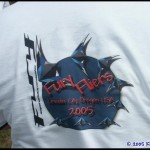 I observed many small incidents of pilots sharing amongst themselves – small things at first and then more and more. Someone going to the lunch tent brings someone on a different team a bottle of water, unasked. Folks picked up blown-down banners without regard to who the owner happened to be. People shared small bits of kite gear amongst each other. Team patches and pins and email addresses got swapped. Pilots began discussing various kites and techniques and maneuvers freely, in spite of any language differences. I saw a real “community” developing on the kite field that WSKC week. There were some pretty special people out on that field during WSKC – and certainly no “bad” ones that I know about!
I observed many small incidents of pilots sharing amongst themselves – small things at first and then more and more. Someone going to the lunch tent brings someone on a different team a bottle of water, unasked. Folks picked up blown-down banners without regard to who the owner happened to be. People shared small bits of kite gear amongst each other. Team patches and pins and email addresses got swapped. Pilots began discussing various kites and techniques and maneuvers freely, in spite of any language differences. I saw a real “community” developing on the kite field that WSKC week. There were some pretty special people out on that field during WSKC – and certainly no “bad” ones that I know about!
Speaking of attendees, the competition pilots and event staff weren’t the only people in Lincoln City for the WSKC… It was interesting to meet several notable people there, including some surprises…
Gerard Clement from Berck sur Mer was there for most of the week, and it was delightful to have him with us. If you’re not up on the international kiting scene, Gerard is the Organizer of the Berck sur Mer Kite Festival, which will host the WSKC again next year. Indeed, Gerard and the Berck Festival have been responsible for starting the first WSKC in 2002 after the old “World Cup” ceased to exist.
We were also especially pleased to have Mr. Liu Zhiping from the The Weifang International Kite Festival Executive Committee from The People’s Republic of China with us for the week. Mr. Liu was in attendance to observe the competition and festivities at the invitation of Dave Gomberg as AKA President.
Three of the AKA Regional Directors also showed up – Gayle Woodul of Region 8, Donald “Doc” Counce from Region 9, and Brian Champie representing Region 11. Both Doc and Brian spent a fair amount of time on the beach, showing off their “Big Toys.” With these large kites flying on relatively short lines anchored on the beach, the kites themselves flew at 30-50 feet above the level of the flying field as you looked out over the Pacific… a marvelous show. There were other SLK beach artists, too… Deb Lenzen, Al Sparling, and Pete Dolphin to name just three.
In case you imagine that large SLK pilots and the general public were the only spectators, there were several noteworthy sport kite pilots of note in attendance as well. The Lummases – Mark, Jeanette, and Ben arrived in fine style, with Mark and Jeanette flying dualie and quad-line demos as Team BiDance, and they were later joined by Susan Shampo in a demo (As “TriDance?”). Carl Robertshaw also arrived, flew several of his marvelous Serpent Delta SLKs, and performed in several sport kite demos and mega-flies. Carl is the designer/manufacturer of the Fury kite flown in the WSKC comps by several of the teams. Miguel Rodriguez of California Wasp fame also attended and demonstrated his marvelous kite. Last but not least, our very own John Barresi performed two different quad line demonstrations.
It was interesting to note that both Mark Lummas and Carl Robertshaw are former world champions in prior international team championship competitions – Mark as a member of Team Sky Dance, and Carl flew with AirKraft. Kitelife found that interesting enough to ask both Mark and Carl for their opinions regarding both the present competition and the future of the World Sport Kite Championships.
I caught Carl as he came off the field after flying a demo on Friday afternoon when the competition had ended. Carl was clearly delighted with the WSKC competition that he’d seen, and was excited that the battle for top prize had run right down to the wire. He felt energized by the overall competitiveness of the top half-dozen teams. Regarding the future of the WSKC, Carl felt that the format and rules were adequate, though he expects them to evolve in the future over time. He did mention the Freestyle World Championships that occurred in France earlier this year, and said he would expect some of the aspects of that competition and flying style to work their way into future international kite team competitions. Thanks, Carl!
Mark Lummas and I also had a chance to chat later in the evening, following the WSKC banquet and awards presentations. Mark, too, thought the WSKC had gone rather well, and was pleased with both the level of competition he’d observed during the week and the results. The discussion took a sideways turn while I asked Mark several questions regarding his comments about flying styles and judging criteria which will go unreported here. We did manage to get back on track enough for me to understand that Mark and Carl agreed regarding the current and future competitiveness of the teams and the format of the event.
All comments from WSKC competitors and the other observers seem to indicate that the event was well-run, exciting to watch or participate in, and will be worthwhile in the future. Indeed, several teams indicated they would go home and plan to be in Berck in 2006. I also know of several of this year’s non-participants who hope to be in Berck sur Mer for the WSKC next year as well.
Now before I close, I’m going to take a little side-step and recognize several people here. The three major players in the WSKC for 2005 were:
Dave Gomberg – President of the AKA. Mr. Gomberg allocated some of his AKAs volunteer resources, it’s true. He also reserved many tasks for himself personally, including a fair amount of the coordination efforts and several of the publicity and media contacts. In addition, Dave contributed some of the event’s financial backing, plus the Gombergs hosted a party at their home for everyone connected with the event.
Sandy Pfaff – Executive Director of the Lincoln City Visitors and Convention Bureau (VCB), and her most able assistants, Ron Sears and Amber Baker. The VCB either performed or coordinated many of the event’s activities including: field setup, vendor coordination, luncheon meals for the entire event, and much of the event’s publicity. The VCB performed flawlessly throughout, and we certainly thank them for all their efforts and involvement.
Susan Skinner – of the AKA, as “Event Coordinator.” Sue went to extraordinary lengths in booking all of the transportation (Yes – world wide), allocating all of the lodgings, and handling most of the oddities that occur in an event of this size and caliber. The fact that she was caught smiling and laughing just before the event started will testify to this lady’s phenomenal abilities. Sue continued to persist, however, and she was found laughing again at the end of the event – while she was out rounding up “just a few more” folks to fly some Demos, after the final competitions ended. Sue – you’re simply awesome. Thank you!
Then there was the staff…
Judging for the WSKC event was handled by five individuals:
Chief Judge: Mike Gillard, AKA
Judge: Mike Huff, AKA
Judge: John Mitchell, STACK
Judge: Peter Fiedler, STACK
Judge: Hideo Wakuzawa, AJSKA
The Field Director for the WSKC this year was Kathy Jarvis from STACK. She held the event in the palm of her hand and nursed it along, keeping it on time, on track, and out of trouble. “Impressive” doesn’t even begin to cover it!
And there was also an able sideline crew, consisting of Tracy Erzin of AKA (Scorekeeper), Jeff Erzin of AKA (Sound Man), and Bob Wendt of AKA (Announcer). All three performed flawlessly.
Again – high praise and hearty “Thanks” to all concerned!
Finally, I’d be remiss if I didn’t offer you a bit of overall perspective on the term “Kite World Championship.”
…and before I go any further, I need to point out that I don’t wish to downplay ANY of the events, or people, or championships I’m about to mention here…
The format for the World Sport Kite Championships has been around for quite a while now, and is one of the few Kiting World Championship events that seems pretty universally accepted. The recent Freestyle World Cup tournament held in France earlier this year also seems to be fairly well accepted as a “World Championship” event by a wide variety of pilots at this point. Does this mean that there are actually TWO “Kiting” world champions, then?
Well, not if you also consider the Snowkite World Championships held in Obertauern, Austria back in February. Okay – so THREE? Again, maybe we have to include a Kiteboard World Cup event held in Italy back in June/July this year. FOUR? And how about 16 year old Aaron Hadlow of Great Britain who has been crowned Kitesurfing World Champion. FIVE? And is there a KAP (kite aerial photography) World Champ?
So the points for consideration are…
The term “World Champion” has much to do with universal acceptance…
The rules for crowning a “World Champion” will change and evolve…
We might see an individual kiting “all-round” World Champion someday…
… but not this year!
All that said, what will become of the World Sport Kite Championship event? If you asked the attendees – both competitors and non-competitors – they’d tell you that the event is alive and well. In addition, those who tend to take the “long view,” will also note that some of the tricks so integral to the Freestyle World Cup will likely migrate over into the Precision and Ballet routines in the WSKC event over time. And perhaps some of the other “rules” in the Freestyle event will also be adopted into the WSKC as well.
Will this happen easily or quickly? The answer is “No” to both, simply because the International Rule Book Committee (IRBC), which is the “international rules consensus committee,” is unlikely to move with much haste. Rather, common sense suggests that the IRBC committee members will poll their own membership about any suggested rule changes first and actually make changes when consensus is reached. The IRBC, by the way, also holds the rule book for individual and pairs events that govern most international competitions.
Therefore, those of us who look forward to the coming WSKC to be held in Berck sur Mer next spring can rest easy. The rules won’t change much, if at all, and we’ll certainly be able to recognize the event… See you there?
Fair Winds and Good Friends,
Dave “Geezer” Shattuck


